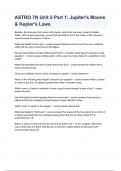Jupiter Study guides, Class notes & Summaries
Looking for the best study guides, study notes and summaries about Jupiter? On this page you'll find 610 study documents about Jupiter.
Page 2 out of 610 results
Sort by
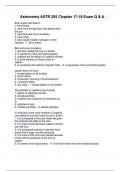
-
Astronomy ASTR 205 Chapter 17-19 Exam Q & A
- Exam (elaborations) • 18 pages • 2023
-
Available in package deal
-
- $10.00
- + learn more
Both Jupiter and Saturn 1. All of these 2. emit more energy than they absorb from the sun. 3. have belt and zone circulation. 4. have rings. 5. have liquid metallic hydrogen in their interiors. - 1. All of these Belt and zone circulation 1. has been observed only on Jupiter. 2. is caused by rising and sinking gases. 3. explains the formation of Cassini's division. 4. is more obvious on Saturn than on Jupiter. 5. is caused by the planet's magnetic field. - 2. is caused by rising a...
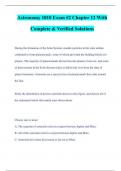
-
Astronomy 1010 Exam #2 Chapter 12 With Complete & Verified Solutions
- Exam (elaborations) • 12 pages • 2023
-
- $10.49
- + learn more
During the formation of the Solar System, smaller particles in the solar nebula combined to form planetesimals, some of which provided the building blocks for planets. The majority of planetesimals did not become planets, however, and some of them remain in the Solar System today as debris left over from the time of planet formation. Asteroids are a special class of planetesimals that orbit around the Sun. Study the distribution of known asteroids shown in this figure, and choose all of t...
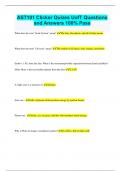
-
AST101 Clicker Quizes UofT Questions and Answers 100% Pass
- Exam (elaborations) • 32 pages • 2024
-
- $9.99
- + learn more
AST101 Clicker Quizes UofT Questions and Answers 100% Pass What does the term "Solar System" mean? The Sun, the planets, and all of their moons What does the term "Universe" mean? The totality of all space, time, energy, and matter Earth is 1 AU from the Sun. What is the maximumpossible separation between Earth and Mars? (Hint: Mars is the next farthest planet from the Sun) 2.5 AU A 'light year' is a measure of: distance Stars are... balls of plasma which produce energy ...
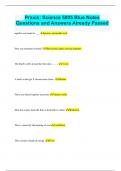
-
Praxis: Science 5005 Blue Notes Questions and Answers Already Passed
- Exam (elaborations) • 29 pages • 2023
- Available in package deal
-
- $9.99
- + learn more
Praxis: Science 5005 Blue Notes Questions and Answers Already Passed aquifers are found in ___. porous, permeable rock How are mountains formed? By tectonic plates moving together. The Earth's orbit around the Sun takes ____. 1 year A male would get X chromosome from-- Mother These are linked together in protein Amino Acids Heat that comes from the Sun to the Earth is called- Radiation This is caused by the burning of coal Acid Rain This contains chemical energy. Food Why does our body ...
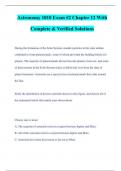
-
Astronomy 1010 Exam #2 Chapter 12 With Complete & Verified Solutions
- Exam (elaborations) • 12 pages • 2023
-
Available in package deal
-
- $9.49
- + learn more
Astronomy 1010 Exam #2 Chapter 12 With Complete & Verified Solutions During the formation of the Solar System, smaller particles in the solar nebula combined to form planetesimals, some of which provided the building blocks for planets. The majority of planetesimals did not become planets, however, and some of them remain in the Solar System today as debris left over from the time of planet formation. Asteroids are a special class of planetesimals that orbit around the Sun. Study the distribut...
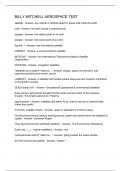
-
Billy Mitchell Aerospace Test
- Other • 16 pages • 2023
-
- $7.99
- + learn more
satellite - Answer- any natural or artificial object in space that orbits the earth orbit - Answer- the path around a celestial body apogee - Answer- the highest point in an orbit perigee - Answer- the lowest point of an orbit Sputnik 1 - Answer- the first artificial satellite COMSAT - Answer- a communications satellite INTELSAT - Answer- the International Telecommunications Satellite Organization NAVSTAR - Answer- navigation satellites "Satellites as a system" refers ...
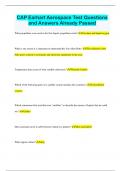
-
CAP Earhart Aerospace Test Questions and Answers Already Passed
- Exam (elaborations) • 22 pages • 2024
- Available in package deal
-
- $9.99
- + learn more
CAP Earhart Aerospace Test Questions and Answers Already Passed What propellants were used in the first liquid- propellant rocket? Gasoline and liquid oxygen What is one reason it is important to understand the Van Allen Belts? The radiation in the belts poses a threat to astronauts and electronic equipment in the area. Temperature data is part of what satellite subsystem? Thermal Control Which of the following parts of a satellite system includes the customers? Constellation sy...
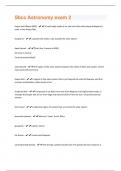
-
Sbcc Astronomy exam 2 Questions With 100% Correct Answers
- Exam (elaborations) • 10 pages • 2024
- Available in package deal
-
- $7.99
- + learn more
Kuiper belt Object (KBO) - A small body made of ice and rock that orbits beyond Neptune's orbit, in the Kuiper Belt. Exoplanet - a planet that orbits a star outside the solar system dwarf planet - Pluto (has 5 moons in KBO) Eris (has 5 moons) Ceres (in asteroid belt) asteroid belt - the region of the solar system between the orbits of Mars and Jupiter, where many asteroids are found Kuiper belt - A region of the solar system that is just beyond the orbit of Neptune and that contains sm...
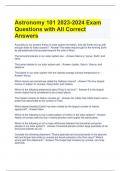
-
Astronomy 101 2023-2024 Exam Questions with All Correct Answers
- Exam (elaborations) • 23 pages • 2023
-
Available in package deal
-
- $13.99
- + learn more
Astronomy 101 2023-2024 Exam Questions with All Correct Answers According to our present theory of solar system formation, how did Earth end up with enough water to make oceans? - Answer-The water was brought to the forming Earth by planetesimals that accreted beyond the orbit of Mars. The terrestrial planets in our solar system are: - Answer-Mercury, Venus, Earth, and Mars. The jovian planets in our solar system are: - Answer-Jupiter, Saturn, Uranus, and Neptune. The planet in our so...
ASTRO 7N Unit 2 Part 1 Jupiters Moons & Keplers Laws with complete solution / Latest updated .

Study stress? For sellers on Stuvia, these are actually golden times. KA-CHING! Earn from your study resources too and start uploading now. Discover all about earning on Stuvia



